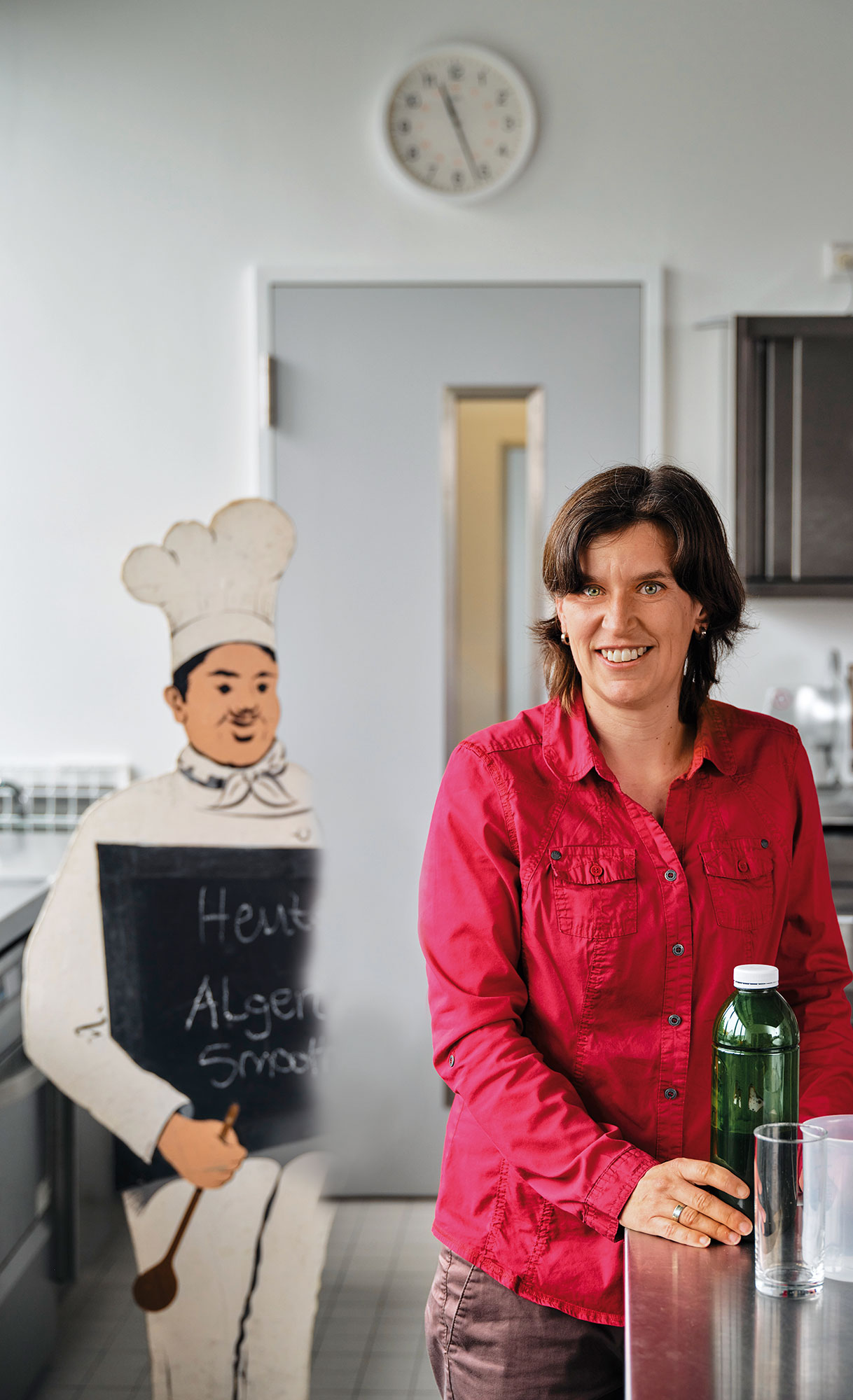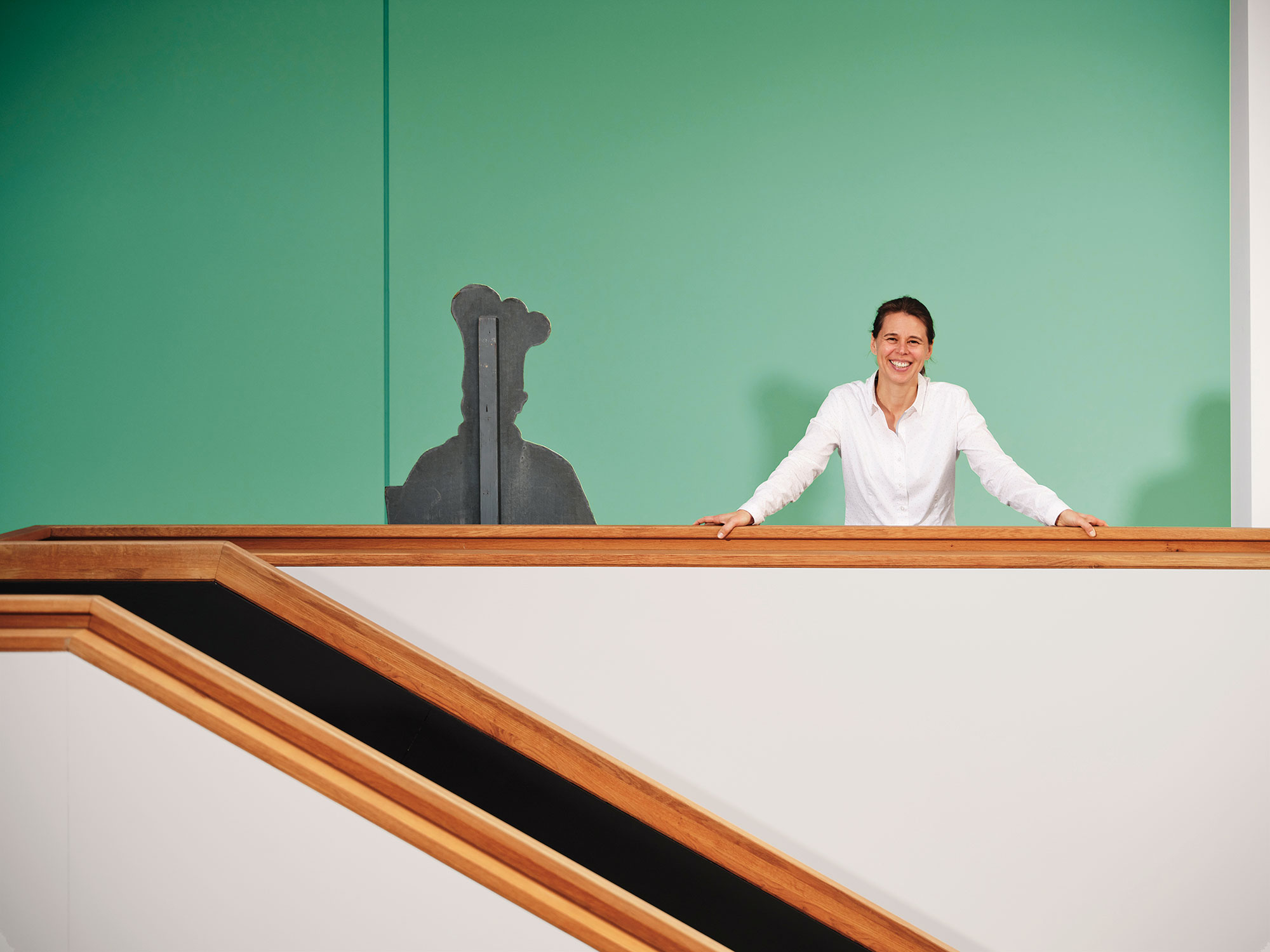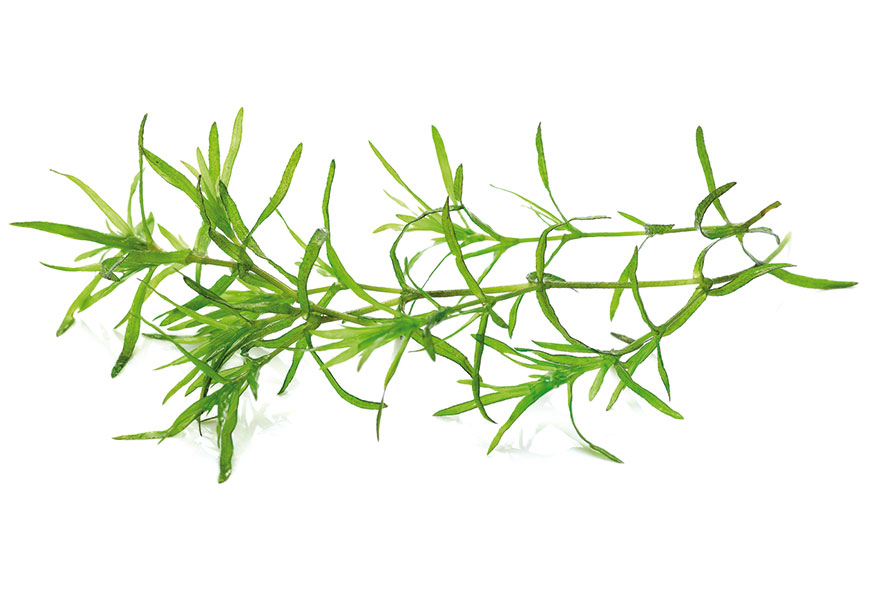
Our diet is about to go green
Feeding the world

Webspecial Fraunhofer magazine 3.2022
The United Nations has calculated that on November 15, the world’s population reached the eight billion mark, meaning that it has doubled in only 50 years. Although the growth rate has significantly slowed in recent years, predictions show that the population will rise to 8.5 billion by 2030, and 9.7 billion by 2050. More people mean less arable land, less drinking water and less food per head of population. Now, with the climate crisis, these shortages are noticeably worsening. Desertification, a process whereby soil deteriorates to the point where the landscape becomes a desert, claims a worldwide acreage the size of Bavaria each year. Within the past 40 years alone, one-third of all fertile land has become unusable – the result of excessive crop cultivation and overgrazing. What’s more, our food requirements are set to grow by around 70 percent between now and 2050, estimates the Deutsche Gesellschaft für Internationale Zusammenarbeit (GIZ) GmbH (German society for international collaboration). However, certain aquatic organisms – quite unjustly relegated to a niche existence in the agriculture and food industry, particularly in Europe – could be of help here: algae. Algae have as much protein as the soybean, are rich in valuable nutrients like fiber and minerals, and contain vitamin B12, which can otherwise only be found in animal products. This superfood does not require fresh water or land. It grows sustainably in the sea, or can be cultivated as single-celled microalgae, normally in enclosed facilities.
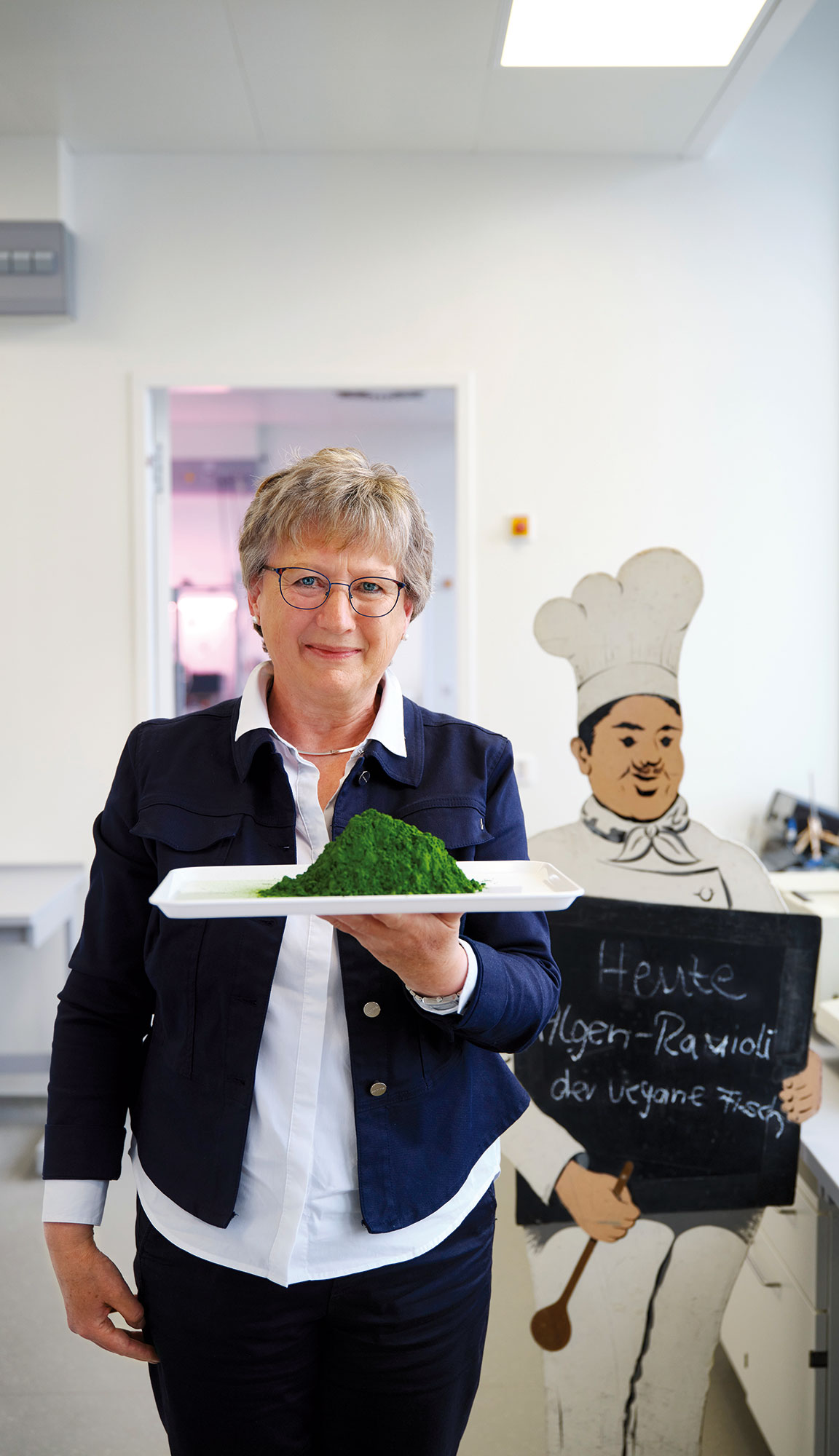
Tiny but mighty
Dr. Ulrike Schmid-Staiger is group manager for Algae Biotechnology at the Fraunhofer Institute for Interfacial Engineering and Biotechnology IGB in Stuttgart. For 25 years now, she has been perfecting the cultivation of microalgae in photobioreactors – transparent water tanks that supply the tiny organisms with light, CO2 and nutrients until they grow to form a thick green soup. Dr. Schmid-Staiger currently devotes most of her time to the marine Phaeodactylum tricornutum, which can generate particularly large quantities of omega-3 fatty acids, and to Chlorella vulgaris, which feels most at home in ponds and brackish water and stands out thanks to its high protein content of around 50 percent. When suspended in water, neither alga is detectable to the naked eye.
“Compared to terrestrial plants, our algae contain around ten times the amount of valuable nutritious substances,” declares Dr. Schmid-Staiger with pride. Every single cell contains the same rich mix of nutrients. Terrestrial plants, on the other hand, also have roots, stalks and leaves. The substances contained in the cells vary in the different parts of a plant – the protein content of a corn kernel is different to that of its leaves or roots. “I can make use of every part of the algal biomass we grow here. There is hardly any waste material,” emphasizes Dr. Schmid-Staiger. And these are not the only advantages microalgae have to offer. For one thing, they grow much more quickly than their botanical, land-based cousins. While 1 hectare of farmland can yield around 30 tons of corn biomass, a photobioreactor with artificial lighting can yield up to 150 tons of algae from the same surface area.
Dr. Schmid-Staiger and her team have developed sophisticated systems that can achieve peak yields of some 900 tons per hectare per year. To create these systems, the team from Fraunhofer IGB connects a set of closely packed flatpanel reactors in series; each layer is 3 to 5 centimeters thick. LED panels that shine on both sides are inserted between the reactors, ensuring a sufficient supply of light. “Light is the key ingredient for cultivating algae,” emphasizes Dr. Schmid-Staiger. The light intensity and distribution, which needs to be as uniform as possible, will determine the growth rate. This means that the reactor’s contents have to be mixed continually, so bubbles of air and CO2 are allowed to rise through the container to agitate it. Small baffles on the reactor’s interior walls create a special current that repeatedly swirls each cell past the reactor’s outer surface, so that they always have a sufficient light supply. “If I give them too much light, it will not be used efficiently and then I’m wasting energy. If I give them too little, the algae won’t thrive. We have to find the optimal level between these extremes,” says Dr. Schmid-Staiger. The more the algae grow, the more light is needed – meaning the levels require constant readjustment. And different algae have different needs. “Our Phaeodactylum doesn’t like too much light, for instance. Chlorella, on the other hand, is a sun-worshiper,” says Dr. Schmid-Staiger, chuckling.
A nutrient mix made to order
For a long time, she and her team used to cultivate the algae outdoors. “We had to make do with whatever sunlight was available. We could only produce algae for six months out of the year; after that, the days got too short.” While the artificial lighting costs more, it pays for itself, as productivity is up to ten times higher. Moreover, the closely packed photobioreactors can be installed anywhere, even underground, and stacked one on top of the other. So naturally, they do not take up much surface area. Up to 3.5 tons of algae per year can be grown on a plot of only 20 square meters. The same quantity of soybeans would require an entire hectare of fertile arable land, along with some 2,000 cubic meters of water. The algae can grow in a mere quarter of that space. What’s more, most of the water supply can be recycled to cultivate the next crop. Dr. Schmid-Staiger and her team can adjust the cultivation conditions to make the algae produce greater amounts of certain substances. “Of course, to do this, we need to know what function these substances fulfill in the algal cell. For example, if we increase the nutrient supply, this will cause a rise in protein production, while reducing the supply will result in more carbohydrates and fats,” she explains. Algal proteins are especially in demand in the food industry these days, as they can be used to replace animal proteins. Researchers at the Fraunhofer Institute for Process Engineering and Packaging IVV extract these proteins and add them to vegan foods. The particular challenge here is eradicating their fishy flavor and green coloring.
Fruity, not fishy
Dr. Stephanie Mittermaier, Head of the Food Process Development department, is experimenting with smoothies, pasta and pesto to begin with. Color does not present a problem in those dishes. She uses various flavorings and herbs to mask the taste of the algae. “I like to use strongly flavored fruits in the smoothies, because the acidity comes to the fore and overcomes the fishy flavor,” reveals Dr. Mittermaier. Otherwise, she concentrates on savory products. “Algae can also have a savory or umami flavor.” She is still feeling her way toward finding the right amounts. In the process, she has to bear in mind not only the food’s flavor, but also its consistency. “For example, if I add too high a concentration to the pasta dough, it can start to crumble, which makes it harder to work with.” Does she ever sample her own creations? “Yes, of course, it’s important to do that when you’re experimenting. Just so I know what I’m doing to my testers and our trained panel of institute colleagues,” she says, laughing. In the long term, she can envisage making a good vegan fish substitute by combining algal and plant proteins. The algae’s fishy flavor could even be an advantage here. However, the color still presents a problem. Anyone for green salmon fillet or green cod? No, thanks. “We will probably lean more toward tuna fish. We could achieve a brownish color, but white is not a possibility.” This is because the algal pigments are either proteins themselves, or are so closely bound to the proteins that they cannot be removed without causing damage.
Up to now, microalgae have been sold in tablet form as a food supplement for the most part, while consumers and food industry stakeholders are more familiar with multi-celled marine macroalgae, or seaweed. Most people will have seen this in sushi, where nori, a savory/sweet seaweed, is used to wrap up rice and fish. However, while seaweed has been a dietary staple in the Asiatic world for centuries, Europeans are still dubious about this superfood. It is rarely served in the form of a salad or soup. Yet even consumers that avoid sushi have probably already eaten algae without realizing it, as alginates and carrageen are common food additives. Alginates are often used as a gelatin substitute, while carrageen is added to products such as cream to prevent flocculation and ensure even fat distribution. Just like their smaller algal counterparts, seaweeds have a high protein content of up to 50 percent and feature a rich mix of fiber, fats, vitamins and minerals like zinc, iron, selenium, potassium, calcium and especially iodine. They are usually grown on long ropes under the sea. Seaweed farming is extremely sustainable, as it only uses resources that are already naturally available. However, it does present one disadvantage: Seasonal and climatic fluctuations mean the quality and amount of nutrients the seaweed contains can vary. In addition, processing macroalgae into food products is more difficult than processing their one-celled cousins from the reactor.
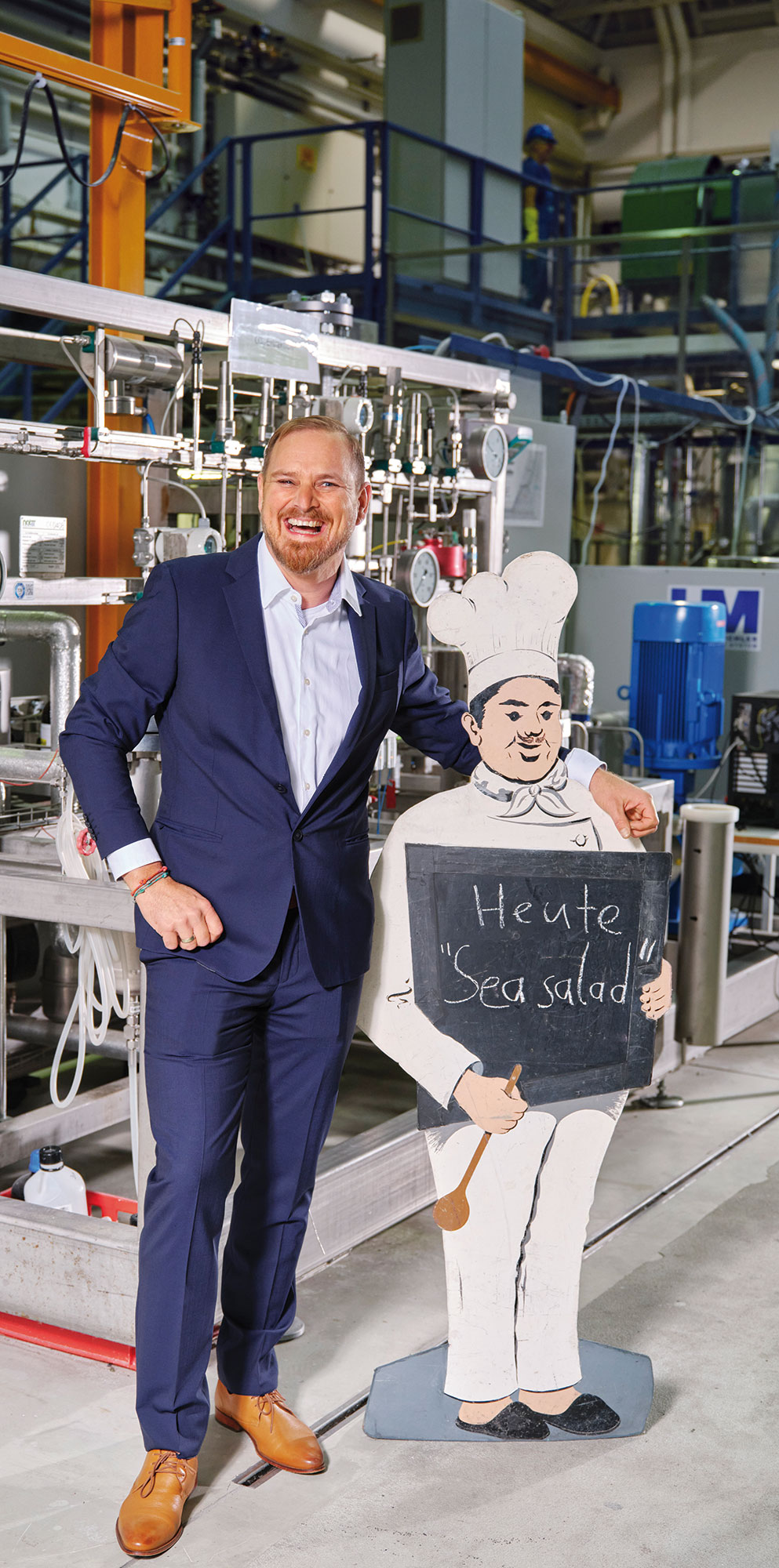
Seaweed sausage?
“Tasty” say the food testers Dominic Wimmer, Project Manager for pilot plants at Fraunhofer IVV, explains: “In barley or wheat, carbohydrates and proteins are simply stored in the center of the kernel. If I put the kernels through a crushing mill, this exposes the endosperm, which I can use right away. However, in seaweed, the proteins and carbohydrates are deeply embedded in the cell wall, so extracting them requires a number of steps. The dried seaweed leaves must first be ground to a fine powder in order to break the cells open as much as possible. Then, to release the valuable nutrients they contain, Mr. Wimmer mixes the seaweed powder with additives such as enzymes harvested from snails that consume and digest algae. He also enlists the aid of hydrochloric acid and a sodium hydroxide solution. The powder is first steeped in water multiple times; the mixture is then warmed and stirred. The nutrients gradually leach out into the surrounding water, which is then repeatedly centrifuged, that is, separated into solids and a rich aqueous solution by means of a centrifuge. This process allows Mr. Wimmer to achieve a yield of up to 90 percent when extracting proteins from seaweed. He has used these proteins to make products like vegan sausages – with great success. The seaweed sausage was an even bigger hit among food testers than its equivalent meat-based product.
Living for seaweed
Mr. Winner “is crazy about seaweed,” as he says himself. The qualified master brewer spent several years as a food industry consultant before moving on to a role as a process engineer at Fraunhofer IVV. Since then, he has been working on a range of projects based on the use of seaweed as a food. One of the products he developed from seaweed was a healthy alternative to salt, which he used to flavor snacks like chips and peanuts; he has also experimented with using algae in bread, meat products, soups and sauces. However, his attempts to eradicate seaweed’s fishy flavor have been unsuccessful so far. “Either we will get used to it, or I will have to keep looking for a way to remove it ,” he says, laughing.
“There is so much goodness in seaweed. There’s no doubt that it’s an important source of nutrition for humanity. I think it offers amazing opportunities for the food industry,” he says with conviction. And the food industry is increasingly taking the same view. The market for vegan products is growing rapidly. According to the Federal Statistical Office of Germany, the country saw a 62 percent increase in the production of foods like vegan sausage and schnitzel between 2019 and 2021. Giving up meat is a trend seen mainly among teenagers and young adults. Compared with the general population, twice as many 15–29 year olds are vegetarian (10.4 percent) or vegan (2.3 percent). A further 25 percent describe themselves as flexitarians, that is, they only eat meat occasionally, while 44 percent want to reduce their consumption in the future, mainly for climate protection and animal welfare reasons. A recent study by Boston Consulting Group has confirmed that alternative protein sources also have a central role to play in food security. The amount of capital invested in this area has increased from 1 billion dollars in 2019 to 5 billion in 2021 – an annual growth rate of 124 percent.
However, many food industry product developers still have no clear concept of how to use algae as a raw material. Elke Böhme and her team at the Fraunhofer Research Institution for Individualized and Cell-Based Medical Engineering IMTE in Lübeck are giving them some guidance. The food specialist hosts regular algae workshops to show stakeholders from the agriculture and food industry the range of ways in which these marine plants can be used. She is also occasionally contacted by companies that want to do “something with algae.” She then tells them about the different types of algae, and describes their features and possible applications. A tasting session is always part of the program. “If workshop participants can taste, smell and feel the products, it makes it much easier to develop their own ideas,” says Mrs. Böhme.
Walnut-flavored seaweed
The range of possible applications is vast. Mrs. Böhme has already integrated algal extracts into muesli bars, barbecue sauce, spreadable pastes, beer, lemonade and gin. “Right now we’re working on a vegan bacon, using red dulse seaweed for its savory umami flavor. We’ve developed a special procedure to bring out the flavor even more effectively,” she says. She also mentions an algae that, when fried, tastes just like bacon. “Of course, its appearance and consistency are different. Up to now, consumers have only been willing to accept substitute products if they imitated the original as perfectly as possible.” This is why Mrs. Böhme uses red dulse as a natural colourant in vegan burger patties, for example. Its color changes from red to brown in the hot pan – just like beef does. Workshop participants are regularly surprised to be faced with seaweed ice cream. “Most of them don’t expect seaweed to be able to taste like walnut,” she says. “To be honest, we were surprised too.” Mrs. Böhme and her colleagues also taste their algae in their unprocessed forms, so they can introduce industry product developers to the full diversity of their flavors. The mildly savory sea spaghetti, or Himanthalia elongata, has been going down particularly well. “We just boil it together with normal spaghetti. This requires less salt, and is a healthier meal containing more dietary fibres”, says Mrs. Böhme. She is convinced that eating habits can be changed. It’s just a question of increasing people’s contact with substitute products. After all, it worked for her: The food specialist has now started using seaweed more often in her own home cooking. What’s her favorite? “Nori, for its lovely dark purple color. And its wonderful umami flavor.”
Further information
- Fraunhofer Institute for Interfacial Engineering and Biotechnology IGB | Algae biotechnology (igb.fraunhofer.de)
- Fraunhofer Institute for Process Engineering and Packaging IVV (ivv.fraunhofer.de)
- Fraunhofer Research Institution for Individualized and Cell-Based Medical Engineering IMTE (imte.fraunhofer.de)

